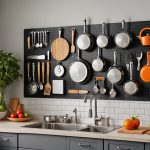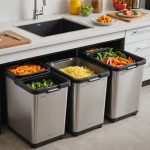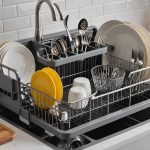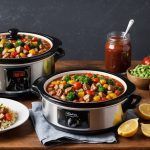Overview of UV-C Air Purifiers
UV-C air purifiers represent a cutting-edge approach to improving air quality, especially in environments like kitchens. These devices use ultraviolet light, specifically UV-C, to sanitize the air by deactivating the DNA of bacteria, viruses, and other pathogens, preventing them from reproducing. Unlike traditional air purifiers which primarily rely on filtration systems, UV-C technology can target microorganisms at a molecular level, making it highly effective.
Ensuring good air quality in the kitchen is critical as it directly impacts respiratory health. Kitchens are a hub for various contaminants including cooking fumes, smoke, and particles from oil and grease. These pollutants arise from routine cooking activities and can be exacerbated by poor ventilation, leading to a buildup of harmful substances in the air.
Also read : Revamp your kitchen: maximize storage and inspire healthy cooking with an innovative pegboard system
Common kitchen contaminants are primarily generated from the cooking process, ranging from smoke and gaseous emissions to minute particles released when ingredients break down under heat. Such pollutants can settle or linger in the air, posing a risk to household members, especially those with respiratory conditions or allergies. As a result, maintaining clear, clean air is vital for promoting health and preventing long-term effects.
Mechanisms for Contaminant Removal
Understanding how contaminant removal works with UV-C technology is key to appreciating its effectiveness. At its core, UV-C technology neutralizes harmful bacteria and viruses by targeting their DNA. The ultraviolet light disrupts the molecular bonds of these microorganisms, rendering them inactive and preventing reproduction. This method is both precise and efficient because it removes not only visible particles but also microscopic pathogens that might evade filtration systems.
This might interest you : Revamp your culinary space: unlock healthier eating habits with a smart waste sorting system
Traditional filtration systems, such as HEPA filters, rely on capturing airborne particles. However, they may fall short in eliminating all types of pathogens because they don’t neutralize them. Instead, these systems can allow certain bacteria and viruses to remain viable. UV-C technology, therefore, offers a distinct advantage by directly inactivating these contaminants, ensuring they are no longer a threat.
The advantages of UV-C technology extend to targeting specific contaminants prevalent in kitchens, such as bacterial spores or volatile organic compounds (VOCs) from cooking processes. This capability makes UV-C air purifiers a superior choice in settings with high contaminant variations. By employing UV-C technology, households can achieve improved air quality and thus better health outcomes.
Health Advantages of UV-C Air Purifiers
Elevating kitchen air quality with UV-C air purifiers provides notable health benefits. This technology drastically reduces respiratory irritants and allergens, leading to improved respiratory health. Given that kitchens are often filled with smoke and particulate matter, which exacerbate conditions like asthma and allergies, employing UV-C purification methods can be a game-changer.
Recent research findings have demonstrated the ability of UV-C air purifiers to effectively diminish airborne pathogens. Studies consistently show that UV-C technology lessens the concentration of allergens and bacteria, contributing to healthier indoor environments. This reduction in indoor pollutants translates into fewer respiratory issues, less frequent allergy flare-ups, and overall enhanced well-being for household members.
The long-term benefits of maintaining superior air quality in the kitchen cannot be overstated. By eliminating harmful contaminants, these purifiers help mitigate potential chronic respiratory conditions. For families with sensitive individuals, including children and the elderly, investing in UV-C air purification is a proactive step for a healthier future. With each use, UV-C air purifiers not only improve environmental hygiene but also promote sustained health improvement, making them a valuable addition to any home.
Choosing the Right UV-C Air Purifier for Your Kitchen
When selecting an air purifier for your kitchen, several critical features warrant consideration to ensure effective kitchen air purification. Firstly, focus on the purifier’s UV-C technology, as it should be robust enough to handle various household contaminants. Look for models with a high-quality UV-C lamp, which ensures durability and efficacy.
Size and capacity are paramount when choosing an air purifier for different kitchen types. A larger kitchen may require a unit with greater air exchange capabilities, measured in air changes per hour (ACH). Conversely, smaller kitchens might benefit from compact models that don’t compromise on performance.
Balancing budget and effectiveness is essential in making a sound investment. While more expensive models may offer enhanced features like multiple filtration stages or smart technology integration, less costly units can still provide substantial improvements in air quality if they effectively incorporate UV-C technology.
Prioritizing these factors ensures that the chosen air purifier not only fits your kitchen’s specific needs but also enhances overall environmental quality, ultimately supporting better health outcomes for household members.
Comparison with Other Air Purification Methods
There are several air purification methods to consider when aiming to enhance home air quality. Among the most notable are HEPA filters and activated carbon filters. These methods have been popular due to their capability to trap particles and neutralise odours. HEPA filters excel at capturing up to 99.97% of particles as small as 0.3 microns, such as dust, pollen, and pet dander.
However, HEPA filters have notable limitations. They do not neutralise airborne microorganisms like bacteria or viruses, leaving these harmful agents active. In contrast, UV-C air purifiers target and inactivate these pathogens, offering a significant advantage in specific scenarios, particularly in kitchen environments where contaminant variation is high.
Activated carbon filters specialise in adsorbing gases and volatile organic compounds, efficiently reducing odours. Yet, for comprehensive air quality improvement, combining such methods with UV-C air purifiers ensures both gaseous and microbial pollutants are addressed. Different situations demand distinct purification approaches, but UV-C technology often proves superior when safeguarding against microscopic pathogens is a priority. Understanding these differences helps consumers make informed choices for optimal household air purification.
Testimonials and Research Findings
UV-C purifier reviews flourish with personal stories that underscore health improvements experienced by users. Many households report reduced allergy symptoms and fewer respiratory illnesses after integrating UV-C air purifiers. These consumer experiences highlight the tangible benefits of enhanced indoor air quality.
Scientific research underpins these testimonials, verifying the efficacy of UV-C technology in air purification. Numerous scientific studies confirm that UV-C purifiers significantly lower the concentration of airborne pathogens. For instance, studies have observed a marked reduction in bacterial and viral counts in environments utilizing UV-C air purifiers, aligning with consumers’ positive feedback.
Independent reviews offer an objective lens, appraising the practical benefits of UV-C air purifiers. These reviews reinforce the role of UV-C technology as a crucial tool for maintaining healthier indoor spaces. By providing empirical evidence and user perspectives, independent reviews help consumers make informed decisions when selecting air purification solutions. They ensure that choices are grounded in proven effectiveness, solidifying UV-C air purifiers’ position in the realm of air quality management.











